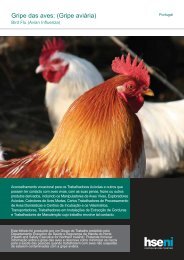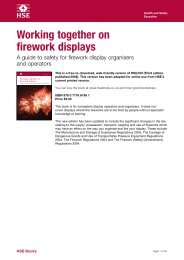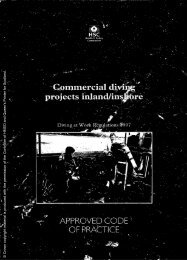The safe isolation of plant and equipment (HSG253) - Health and ...
The safe isolation of plant and equipment (HSG253) - Health and ...
The safe isolation of plant and equipment (HSG253) - Health and ...
You also want an ePaper? Increase the reach of your titles
YUMPU automatically turns print PDFs into web optimized ePapers that Google loves.
<strong>Health</strong> <strong>and</strong> Safety<br />
Executive<br />
161 <strong>The</strong> necessary extent <strong>of</strong> purging <strong>and</strong> flushing will depend on the substance<br />
concerned <strong>and</strong> the nature <strong>of</strong> the intrusive activity. For example, very stringent<br />
control is required where intrusive hot work is to be carried out on systems that<br />
have contained flammable substances. 10 Precautions may include:<br />
■<br />
■<br />
■<br />
■<br />
■<br />
■<br />
■<br />
depressurise to atmospheric pressure;<br />
cool (or heat, for cryogenic systems);<br />
drain;<br />
water flush <strong>and</strong>/or fill;<br />
nitrogen purge;<br />
others such as air movement, high-pressure water jetting, back flushing,<br />
detergent wash; <strong>and</strong><br />
demonstrating a non-explosive atmosphere (substantially below lower explosive<br />
limit (LEL)), internally, immediately before the work starts.<br />
162 Specify arrangements for control, calibration <strong>and</strong> checking <strong>of</strong> test <strong>equipment</strong><br />
in your procedures. Where necessary, ensure that gas testing <strong>equipment</strong> is suitable<br />
for use after purging (ie that measurements will not be adversely affected by the<br />
presence <strong>of</strong> inert gas or depleted levels <strong>of</strong> oxygen).<br />
163 When testing <strong>plant</strong> <strong>and</strong> pipelines to prove that they are totally gas or vapourfree,<br />
ensure that a representative sample is taken. For large items <strong>of</strong> <strong>plant</strong>, you<br />
may need top, middle <strong>and</strong> bottom samples to ensure that no light or heavy gases<br />
remain.<br />
164 Testing <strong>of</strong> pipelines requires special care, as the point <strong>of</strong> <strong>isolation</strong> may be<br />
some distance from the sampling point. In such circumstances you should consider<br />
installing a sample point closer to the <strong>isolation</strong> point to verify its gas or vapour-free<br />
status.<br />
Testing <strong>and</strong> monitoring effectiveness <strong>of</strong> the <strong>isolation</strong><br />
165 Prove the integrity <strong>of</strong> all <strong>isolation</strong> points <strong>of</strong> an <strong>isolation</strong> scheme before<br />
proceeding with intrusive work (unless your risk assessment has indicated that use<br />
<strong>of</strong> non-proved <strong>isolation</strong> is acceptable):<br />
■<br />
■<br />
■<br />
each part <strong>of</strong> the <strong>isolation</strong> should be proved separately, eg prove each valve in a<br />
double block <strong>and</strong> bleed scheme;<br />
each part should be proved to the highest pressure which can be expected<br />
within the system during the work activity. Particular care is required when there<br />
is a low differential pressure across valves where the sealing mechanism is<br />
activated by pressure; <strong>and</strong><br />
where possible, each part <strong>of</strong> the <strong>isolation</strong> should be proved in the direction <strong>of</strong><br />
the expected pressure differential.<br />
166 For a positive <strong>isolation</strong> scheme, there are two stages <strong>of</strong> testing. Prove both<br />
the initial (valved) <strong>isolation</strong> <strong>and</strong> the final <strong>isolation</strong>.<br />
167 Your procedure for installing the <strong>isolation</strong> should clearly specify the<br />
arrangements for proving the <strong>isolation</strong>, the test success criteria <strong>and</strong>, for positive<br />
<strong>isolation</strong>s, the pressure to be applied (see paragraphs 180-183).<br />
168 Do not rely on an <strong>isolation</strong> that is unproved because the facilities are not<br />
present, or where you lack confidence in the test. Extend the <strong>isolation</strong> boundary or<br />
defer the work until shutdown. You should also consider <strong>plant</strong> modification to install<br />
facilities for testing that <strong>isolation</strong> point in future (see paragraphs 138-139).<br />
<strong>The</strong> <strong>safe</strong> <strong>isolation</strong> <strong>of</strong> <strong>plant</strong> <strong>and</strong> <strong>equipment</strong> Page 35 <strong>of</strong> 81







